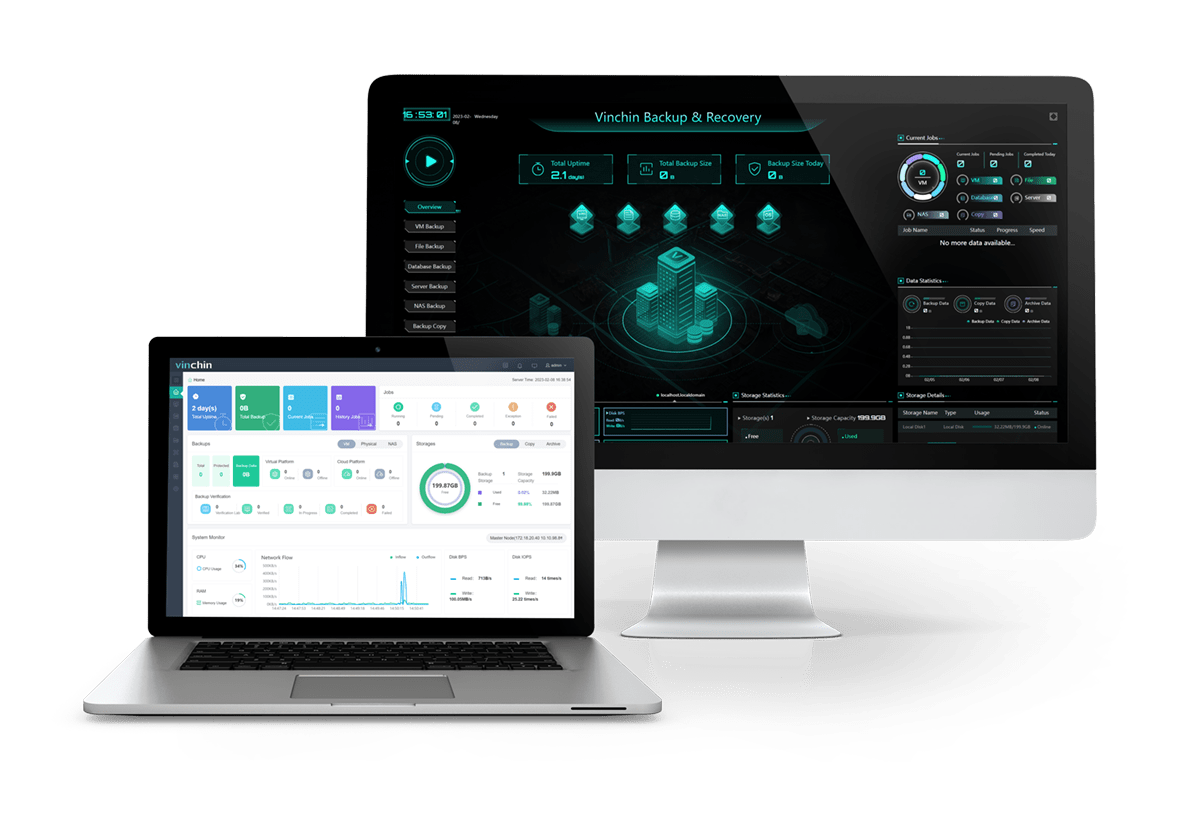-
What is offsite backup?
-
How does offsite backup work?
-
The “3-2-1” rule for data backup
-
Offsite backup types
-
Offsite backup vs onsite backup
-
Why should backup media be stored offsite?
-
Offsite backup with Vinchin solution
-
Conclusion
With the deepening development of informatization, the data of enterprises is growing. And while a large amount of data brings wealth to enterprises, the losses caused by data loss are also increasing. Therefore, the importance of backup and disaster recovery becomes evident. Although some companies have implemented internal data backup solutions, this only solves a part of the company’s data security problems and does not address local threats to data, such as computer theft or accidental fires that can cause local data loss. Regardless of whether a company has implemented a data backup project or not, offsite backup is an important part of addressing data security.
What is offsite backup?
Data backup is the foundation of disaster recovery. It refers to the process of duplicating all or part of a data set from the working host's hard drive to another storage medium in order to prevent data loss caused by operational errors or system failures. Traditional data backup methods can only prevent human errors and similar issues, which usually need a long tome to recover all the data. With the continuous development of technology and the exponential growth of data, many enterprises are now adopting offsite data backup methods.
Offsite backup, or off-premise backup, is the copy of files, systems, and other critical data sent out of the main location using removable storage media (like tape) or a remote backup service. Transporting data backups offsite guarantees the servers can be reloaded with the recent data if the system crashes, hardware fails, or hacker attacks.
How does offsite backup work?
Offsite backup is a cross-regional backup strategy where backup data from the source database is transmitted to a remote server. It ensures data reliability through methods like regular backups, incremental backups and so on. The main principle of offsite backup is to synchronize the data from the source site to the backup site while maintaining data consistency and synchronization.
Through offsite backup, backup data is replicated and stored at a location far away from the original data site. This location is typically in a different geographic area, different data center, or on servers provided by a cloud storage service provider. The benefit of this approach is that even if a catastrophic event such as a fire, flood, or earthquake occurs at the original data location, the backup data remains secure and can be used for data recovery and business continuity purposes.
The “3-2-1” rule for data backup
3 Copies: Maintain three copies of your data, including the original and two additional backup copies. This ensures that even if one copy is damaged, there are still two additional copies available for data recovery.
2 Storage Media: Store the backup copies on at least two different types of storage media, such as internal drives, external disks, tapes, flash drives, network storage, or cloud storage. This reduces the risk of losing data due to a single type of storage media failure.
1 Offsite Copy: Keep at least one backup copy of your data offsite, where having a remote backup ensures the availability of data even if the local backups are lost. This is important to protect against events like natural disasters.
By following the “3-2-1” rule, a robust data backup strategy is established which could minimize the risk of data loss and help recovery data successfully in various scenarios.
Offsite backup types
1. Offsite server backup keeps backups in a distant secondary data center synchronously or asynchronously, usually along with local backups.
2. Tape backup copies data from primary storage to tape cartridges, which is the common practice of large companies with massive data volumes. While it’s good for long-term retention, it is also difficult to store, backup, and read from anywhere. And it is easily subject to physical damage. Other external drives like CDs and USBs are the same.
3. Cloud backup sends your data to the cloud over a network. It is among the most available and effective ways to store offsite backups. And data recovery from cloud backups is also easy and fast in the event of data loss.
4. Hybrid backup incorporates local backup and cloud or server backup. Data is saved to the on-premise disc for fast backup and recovery, then transferred to a remote server in another location or cloud for protection against data loss disasters.
When performing offsite backups, it is important to consider factors such as backup frequency, data size, network transfer speed, and how to handle exceptional situations like network interruptions or source site failures. To address these issues, techniques such as incremental backups, differential backups, etc., can be used to improve backup efficiency and recovery speed.
Please note that security is a crucial aspect of offsite backups. There have been many stories of data loss or theft in remote backup scenarios, whether it's tape/disk-based or files stored on remote file servers. For this reason. It is always advisable to encrypt the backup files before they leave the server. Be cautious not to lose your password and remember to perform restoration testing.
Offsite backup vs onsite backup
Offsite backup | Onsite backup | |
Advantages |
|
|
Disadvantages |
|
|
Why should backup media be stored offsite?
An onsite backup may be stolen, corrupted, or encrypted by hackers, while an offsite backup saves the day and enables data retrieval in such cases.
1. Away from onsite damages: primary site systems outages from natural disasters or human errors and software failures won’t affect the offsite backup.
2. Improved data security: if ransomware attacks compromise or encrypt the local backups, air-gapped offsite backup without connection to the main networks will survive.
3. Disaster recovery resource: one of the major reasons you keep the offsite backup is to use it as a disaster recovery resource for shorter RTO and RPO supposing there are any accidents.
4. High data availability: you can access your data anytime and anywhere using offsite backup, whether it is a cloud backup or a remote backup copy.
5. Compliance and regulatory requirements: Certain industries and organizations like banks are required to have offsite backups as part of their compliance and regulatory obligations.
Offsite backup with Vinchin solution
Despite the fact that some businesses maintain and store their own off-site backups, the majority of them opt to have their backups handled and kept by third-party solutions that are experts in the commercial protection of off-site data.

Vinchin Backup & Recovery supports 10+ virtualization platforms including VMware, Citrix Hypervisor (XenServer), OpenStack, Oracle OLVM, etc., 6 databases, Linux & Windows Servers, and NAS, which has its own way to perform offsite backups and protect them from ransomware attacks. Besides, it also supports to archive critical backups to cloud platforms like Amazon S3, Microsoft Azure, Wasabi and MinIO.
Before backup submission, the solution allows you to automate backup on a regular basis with full, incremental, and differential backup via self-define schedules and mail alerts. This ensures that you have multiple data backups available for later use.
Vinchin Backup & Recovery has been selected by thousands of companies and you can also start to use this powerful system with a 60-day full-featured trial! Also, contact us and leave your needs, and then you will receive a solution according to your IT environment.
Conclusion
Offsite backup is an important component of data management and disaster recovery plans, providing an additional layer of data protection against a variety of risks and threats. Whether it is an individual user or an enterprise organization, an off-site backup strategy can ensure the security, integrity and availability of data. Enterprises should choose the appropriate backup method based on their own needs and resources. At the same time, backup strategies should be frequently verified and updated to meet changing project needs and technical environments.
To efficiently protect data offsite, you can choose Vinchin Backup & Recovery to easily backup and recover your data. Don't miss the free trial.
Share on:








